By Leen Randell
Updated: Jul 04, 2024
10 Best Herbal Decoctions For Inflammation
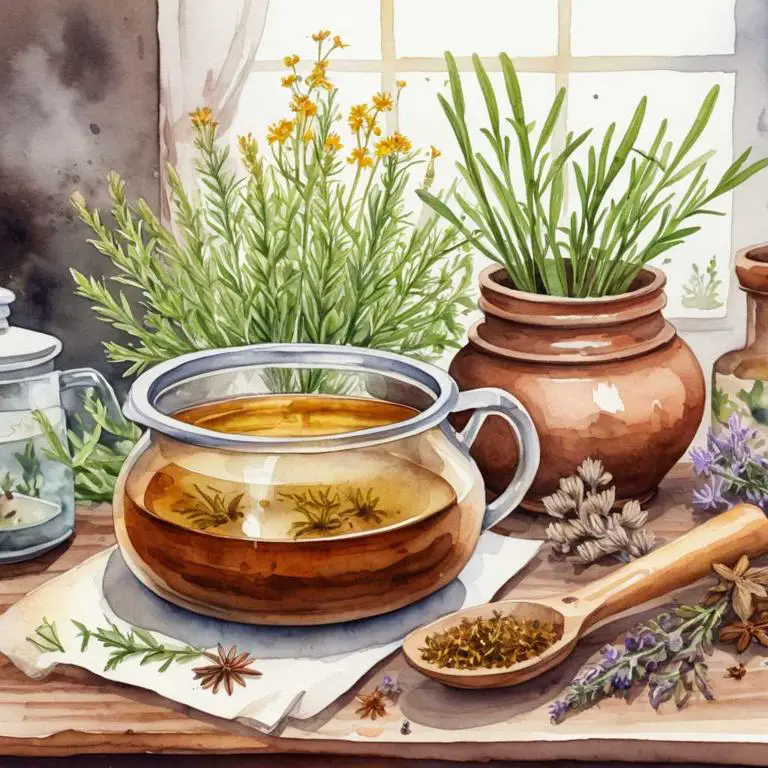
Herbal decoctions for inflammation are liquid extracts made by steeping herbs in hot water, which have been used for centuries to alleviate painful swelling and discomfort.
By harnessing the natural anti-inflammatory properties of plants, these decoctions help reduce inflammation by blocking enzymes that cause pain and swelling. For example, turmeric decoction has been shown to significantly reduce joint pain and stiffness, while ginger decoction eases menstrual cramps and digestive issues.
By incorporating herbal decoctions into their daily routine, individuals can experience improved mobility, reduced discomfort, and enhanced overall well-being.
The following article describes in detail the most important decoctions for inflammation, including medicinal properties, parts of herbs to use, and recipes for preparations.
- 1. Curcuma longa
- 2. Zingiber officinale
- 3. Harpagophytum procumbens
- 4. Hypericum perforatum
- 5. Salix alba
- 6. Tanacetum parthenium
- 7. Boswellia serrata
- 8. Withania somnifera
- 9. Yucca schidigera
- 10. Ginkgo biloba
- What is the best combination of herbal decoctions to use for inflammation?
- What ailments similar to inflammation are treated with herbal decoctions?
1. Curcuma longa
Turmeric decoctions helps with inflammation because of its unique compound, curcumin, which has potent anti-inflammatory properties.
Curcumin inhibits the production of pro-inflammatory enzymes and hormones, thereby reducing inflammation in the body. It also neutralizes free radicals that can contribute to oxidative stress, further alleviating inflammatory responses.
Additionally, turmeric decoctions have been shown to reduce inflammation by suppressing the activation of certain inflammatory genes, making it a natural and effective way to combat inflammation.
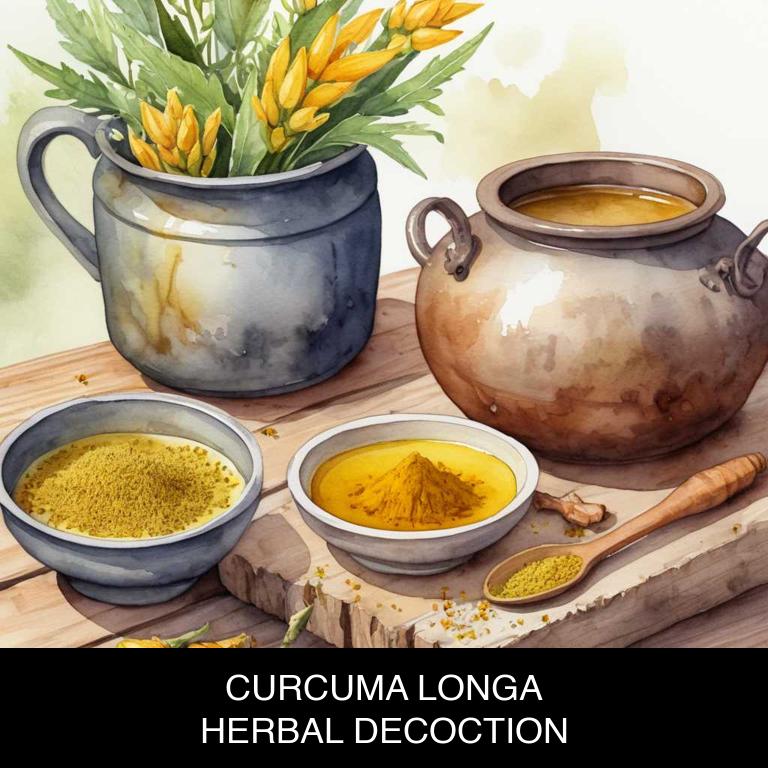
Medicinal Constituents
The list below shows the primary medicinal constituents in Curcuma longa decoctions that help with inflammation.
- Curcumin: It helps with inflammation by inhibiting the activity of pro-inflammatory enzymes, such as COX-2 and LOX, which play a key role in the production of pro-inflammatory mediators.
- Demethoxycurcumin: It helps with inflammation by inhibiting the activity of NF-κB, a transcription factor that regulates the expression of pro-inflammatory genes and contributes to chronic inflammation.
- Bisdemethoxycurcumin: It helps with inflammation by exhibiting antioxidant activity, which helps to neutralize free radicals and reduce oxidative stress, a key contributor to chronic inflammation.
Parts Used
The list below shows the primary parts of turmeric used to make decoctions for inflammation.
- Rhyzomes: Rhyzomes are the most commonly used part due to their high concentration of curcumin, a potent anti-inflammatory compound.
- Leaves: Leaves are used for decoctions because they contain essential oils that help reduce inflammation and pain.
- Roots: Roots are also used in decoctions for their anti-inflammatory properties, which help to alleviate joint pain and swelling.
Quick Recipe
The following recipe gives a procedure to make a basic turmeric for inflammation.
- Measure out 1 teaspoon of dried curcuma longa root powder and place it in a clean glass container.
- Combine the measured root powder with 8 ounces of boiling water in a heat-resistant glass measuring cup.
- Reduce heat to low and simmer the mixture for 10 to 15 minutes or until the liquid has reduced slightly.
- Strain the decoction through a cheesecloth or a fine-mesh sieve into a clean glass container to remove any remaining solids.
- Allow the decoction to cool to room temperature before transferring it to an airtight container for storage.
2. Zingiber officinale
Ginger decoctions helps with inflammation because of its rich antioxidant and anti-inflammatory properties.
The bioactive compounds present in ginger, such as gingerols and shogaols, have been shown to inhibit the production of pro-inflammatory enzymes and reduce the levels of inflammatory markers in the body. Additionally, the decoction's warming and stimulating effects help to increase blood circulation, which can further alleviate inflammation by removing toxins and waste products from the affected areas.
This natural remedy has been used for centuries to soothe joint pain, muscle soreness, and other inflammatory conditions.

Medicinal Constituents
The list below shows the primary medicinal constituents in Zingiber officinale decoctions that help with inflammation.
- Gingerols: These sesquiterpene compounds exhibit anti-inflammatory properties by inhibiting the production of pro-inflammatory cytokines and enzymes, thereby reducing inflammation and pain.
- Shogaols: Similar to gingerols, shogaols have anti-inflammatory effects by suppressing the production of pro-inflammatory mediators and enzymes, which contribute to the reduction of inflammation and pain.
- 6-gingerol: This compound has potent anti-inflammatory and antioxidant properties, which help to reduce oxidative stress and inflammation by scavenging free radicals and inhibiting the production of pro-inflammatory cytokines.
Parts Used
The list below shows the primary parts of ginger used to make decoctions for inflammation.
- Rhyzomes: The most used part, as it is the primary source of ginger's active compounds, which are responsible for its anti-inflammatory properties.
- Roots: The roots of Zingiber officinale are also a significant source of its medicinal properties, and are often used to prepare decoctions for inflammation.
- Stems: The stems, although less commonly used, also contain some of the active compounds found in ginger, and are sometimes used to make decoctions for inflammation.
Quick Recipe
The following recipe gives a procedure to make a basic ginger for inflammation.
- Gather 1-2 teaspoons of dried zingiber officinale root and 8 oz of boiling water in a heat-resistant container.
- Combine the dried root with the boiling water in the container and allow it to steep for 5-7 minutes.
- Strain the mixture through a cheesecloth or fine-mesh sieve into a clean glass container to remove the solids.
- Discard the solids and store the decoction in the refrigerator for up to 3 days or freeze for later use.
- Use 1-2 tablespoons of the decoction as needed to support digestion and alleviate nausea symptoms.
3. Harpagophytum procumbens
Devil's claw decoctions helps with inflammation because of its unique combination of bioactive compounds, particularly harpagosides.
These molecules have potent anti-inflammatory properties, which help to reduce swelling and pain in affected joints and muscles. The decoction's anti-inflammatory effects are also thought to be linked to its ability to inhibit the production of pro-inflammatory enzymes and cytokines, thereby reducing inflammation at its source.
This natural remedy has been traditionally used for centuries to alleviate symptoms associated with arthritis, joint pain, and other inflammatory conditions.
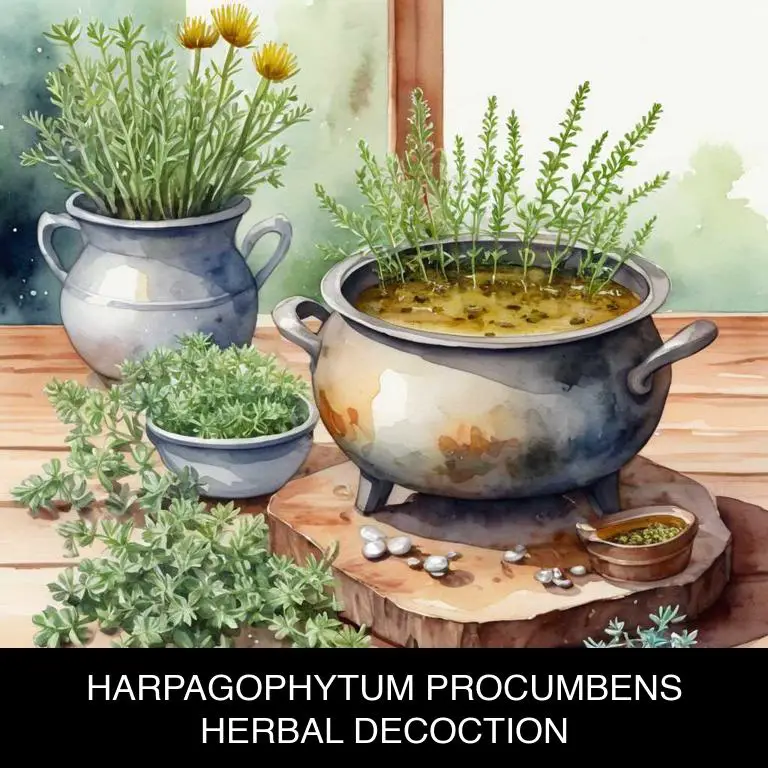
Medicinal Constituents
The list below shows the primary medicinal constituents in Harpagophytum procumbens decoctions that help with inflammation.
- Harpagoside: A iridoid glycoside, harpagoside has anti-inflammatory properties by inhibiting the production of pro-inflammatory mediators and enzymes, such as COX-2 and 5-LOX, which contribute to the inflammatory response.
- Procumbide: A phenylethanoid glycoside, procumbide exhibits anti-inflammatory activity by blocking the production of pro-inflammatory cytokines, such as TNF-α and IL-1β, and by inhibiting the activity of inflammatory enzymes like COX-2.
- Triterpenoid saponins: These compounds have anti-inflammatory effects by modulating the immune response, inhibiting the production of pro-inflammatory cytokines, and reducing the activity of inflammatory enzymes, thereby alleviating inflammation and pain.
Parts Used
The list below shows the primary parts of devil's claw used to make decoctions for inflammation.
- Roots: They contain the highest concentration of active compounds, including harpagoside, which is responsible for the anti-inflammatory effects.
- Stems: Although not as popular as roots, stems are still used due to their lower cost and similar content of harpagoside, making them a more affordable alternative for some applications.
- Barks: Barks are another part used to make decoctions, although they may contain lower concentrations of active compounds compared to roots and stems.
Quick Recipe
The following recipe gives a procedure to make a basic devil's claw for inflammation.
- Gather 60 grams of dried harpagophytum procumbens root and place it in a clean glass jar.
- Combine the root with 1 liter of boiling water in a large pot and reduce heat.
- Simmer the mixture for 10 to 30 minutes or until the liquid has reduced by half slowly.
- Strain the decoction through a cheesecloth into a clean container and discard the solids.
- Allow the decoction to cool and refrigerate it for up to 24 hours before use.
4. Hypericum perforatum
St John's wort decoctions helps with inflammation because of its unique combination of bioactive compounds, particularly hyperforin and hypericin.
These compounds have potent anti-inflammatory properties that work by inhibiting the production of pro-inflammatory molecules, such as cyclooxygenase-2 (COX-2), and reducing the activity of inflammatory enzymes. Additionally, St John's wort decoctions contain antioxidants that help neutralize free radicals, which can contribute to inflammation.
By addressing multiple pathways involved in inflammation, St John's wort decoctions may provide effective relief from conditions such as arthritis, gout, and other inflammatory disorders.

Medicinal Constituents
The list below shows the primary medicinal constituents in Hypericum perforatum decoctions that help with inflammation.
- Hyperforin: A prenylated phenolic compound that inhibits the production of pro-inflammatory cytokines and mediators, thereby reducing inflammation.
- Quercetin: A flavonoid that acts as an antioxidant and anti-inflammatory agent by inhibiting the activity of pro-inflammatory enzymes and blocking the production of pro-inflammatory cytokines.
- Naphthodianthrones: These compounds have anti-inflammatory properties by scavenging free radicals, inhibiting the activity of pro-inflammatory enzymes, and reducing the production of pro-inflammatory cytokines.
Parts Used
The list below shows the primary parts of st john's wort used to make decoctions for inflammation.
- Leaves: They are used due to their high content of flavonoids and phenolic acids, which have anti-inflammatory and antioxidant properties.
- Flowers: They are used due to their high concentration of flavonoids, including rutin and hyperoside, which have potent anti-inflammatory and antioxidant effects.
- Roots: They are used due to their high content of alkaloids, including hypericin and pseudohypericin, which have anti-inflammatory and immunomodulatory properties.
Quick Recipe
The following recipe gives a procedure to make a basic st john's wort for inflammation.
- Collect fresh or dried hypericum perforatum flowers and leaves in quantities of 5-10 grams for each serving.
- Weigh the hypericum perforatum and add it to a pot of boiling water for 10-15 minutes.
- Reduce heat to low and simmer the mixture for 20-30 minutes to release its active compounds.
- Strain the decoction through a cheesecloth or fine-mesh sieve into a clean container to remove solids.
- Allow the decoction to cool and store it in a sealed container in the refrigerator for up to 3 days.
5. Salix alba
White willow decoctions helps with inflammation because of its unique composition.
The decoction contains salicin, a natural compound similar to aspirin, which is responsible for its anti-inflammatory properties. When consumed, salicin is absorbed into the bloodstream and works to reduce pain and swelling by inhibiting the production of prostaglandins, which are hormone-like substances that cause inflammation.
Additionally, white willow decoctions also contain other bioactive compounds like flavonoids and polyphenols, which have antioxidant properties that help protect the body from damage caused by free radicals, further contributing to its anti-inflammatory effects.
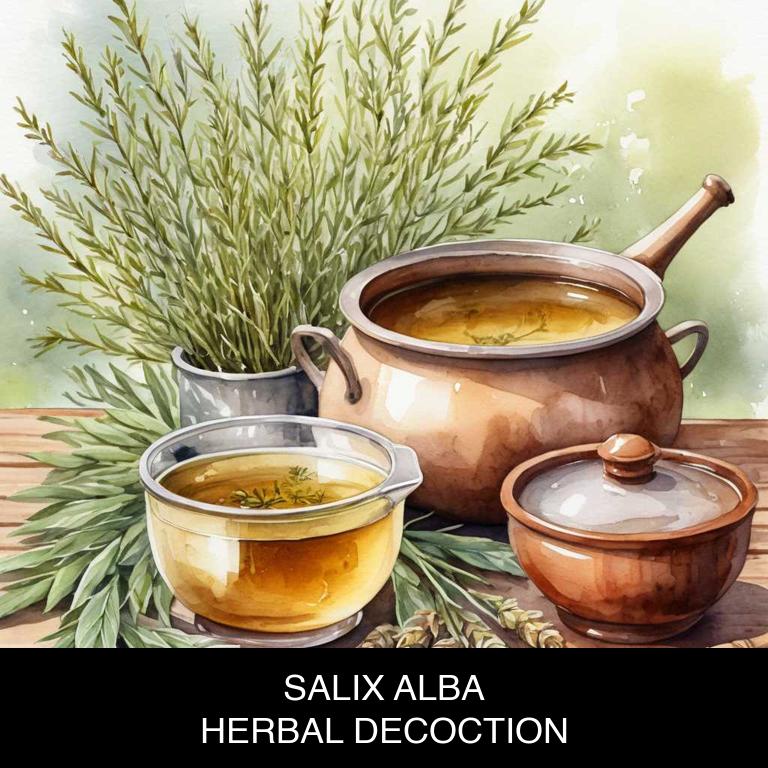
Medicinal Constituents
The list below shows the primary medicinal constituents in Salix alba decoctions that help with inflammation.
- Salicin: Salicin, a phenolic compound, helps with inflammation by mimicking the action of aspirin, inhibiting the production of pro-inflammatory enzymes and reducing pain.
- Salicylic acid: Salicylic acid, a phenolic acid, helps with inflammation by inhibiting the production of pro-inflammatory cytokines and enzymes, and reducing the expression of genes involved in inflammation.
- Flavonoids: Flavonoids, a class of polyphenolic compounds, help with inflammation by scavenging free radicals, reducing oxidative stress, and inhibiting the activation of inflammatory cells and mediators.
Parts Used
The list below shows the primary parts of white willow used to make decoctions for inflammation.
- Barks: The barks of Salix alba are commonly used due to their high content of salicylic acid, a compound that reduces inflammation and pain.
- Leaves: Salix alba leaves are often used in decoctions because they contain flavonoids, which have anti-inflammatory properties that help alleviate swelling and discomfort.
- Buds: The buds of the plant are used in decoctions due to their high concentration of salicylic acid, which helps to reduce inflammation and alleviate pain.
Quick Recipe
The following recipe gives a procedure to make a basic white willow for inflammation.
- Harvest salix alba bark in early spring or late autumn by cutting branches at a 45-degree angle.
- Clean and dry the harvested salix alba bark for at least 24 hours or until completely dry.
- Weigh out 10-20 grams of dried salix alba bark and grind it into a fine powder using a mortar and pestle.
- Combine the ground salix alba powder with 250ml of boiling water and let it steep for 10-15 minutes.
- Strain the salix alba decoction through a cheesecloth or a coffee filter into a clean container.
6. Tanacetum parthenium
Feverfew decoctions helps with inflammation because of its unique composition, which contains parthenolide, a potent anti-inflammatory compound.
This compound inhibits the production of prostaglandins, hormone-like substances that contribute to pain and swelling. Additionally, feverfew's flavonoids and terpenes work synergistically to reduce inflammation by interfering with the activity of pro-inflammatory enzymes and reducing oxidative stress.
As a result, feverfew decoctions can provide relief from conditions such as arthritis, gout, and other inflammatory disorders by targeting multiple pathways involved in the inflammatory process.
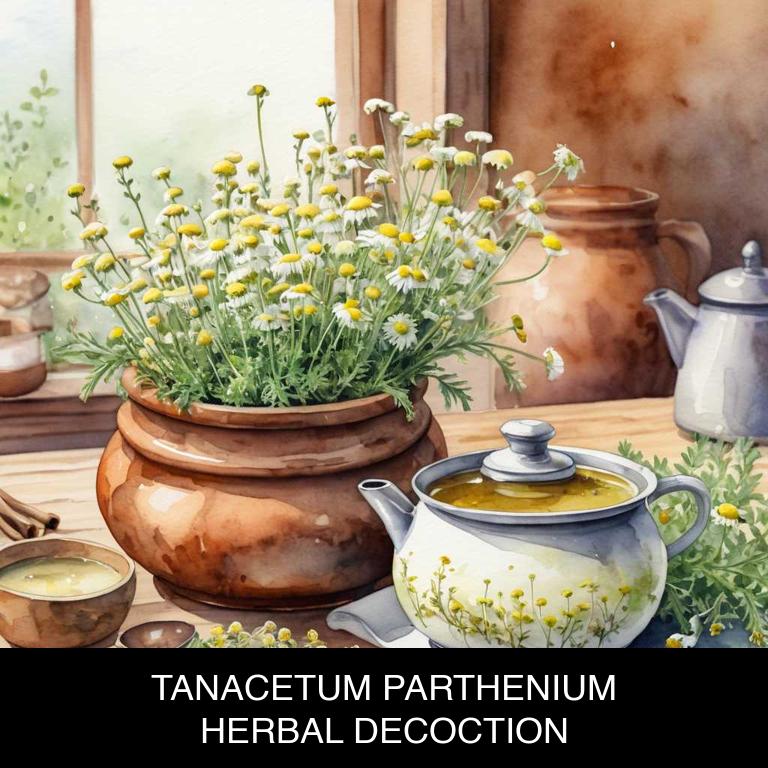
Medicinal Constituents
The list below shows the primary medicinal constituents in Tanacetum parthenium decoctions that help with inflammation.
- Parthenolide: This sesquiterpene lactone is known for its anti-inflammatory properties, as it inhibits the production of pro-inflammatory enzymes and mediators, such as cyclooxygenase-2 (COX-2) and nitric oxide synthase (NOS).
- Tanapartholide: This sesquiterpene lactone has been shown to exhibit anti-inflammatory activity by inhibiting the production of pro-inflammatory cytokines and chemokines, which play a crucial role in the inflammatory response.
- Ligustilide: This sesquiterpene has been reported to have anti-inflammatory properties, possibly through its ability to scavenge free radicals, inhibit the production of pro-inflammatory cytokines, and modulate the activity of various inflammatory enzymes.
Parts Used
The list below shows the primary parts of feverfew used to make decoctions for inflammation.
- Leaves: They are used to make decoctions for inflammation due to their high content of parthenolide, a sesquiterpene lactone with anti-inflammatory properties.
- Flowers: They are used to make decoctions for inflammation due to their high content of volatile oils, which have anti-inflammatory and analgesic effects.
- Roots: They are used to make decoctions for inflammation due to their content of sesquiterpene lactones, which have anti-inflammatory and antioxidant properties.
Quick Recipe
The following recipe gives a procedure to make a basic feverfew for inflammation.
- Harvest 30 grams of fresh tanacetum parthenium flowers or 15 grams of dried flowers at the peak of their potency.
- Rinse the flowers gently with cold water to remove dirt and debris from the surface.
- Steep the flowers in 1 liter of boiling water for 5 to 10 minutes to extract the active compounds.
- Strain the liquid through a cheesecloth or a fine-mesh sieve to separate the solid particles from the liquid.
- Store the decoction in the refrigerator for up to 24 hours and serve at room temperature.
7. Boswellia serrata
Frankincense decoctions help with inflammation because they contain potent anti-inflammatory compounds, including boswellic acids and sesquiterpenes.
These natural chemicals have been shown to inhibit the production of pro-inflammatory enzymes and cytokines, reducing swelling and pain in the body.
By targeting the underlying causes of inflammation, frankincense decoctions can provide relief from chronic conditions such as arthritis, gout, and other inflammatory disorders, promoting overall health and well-being.
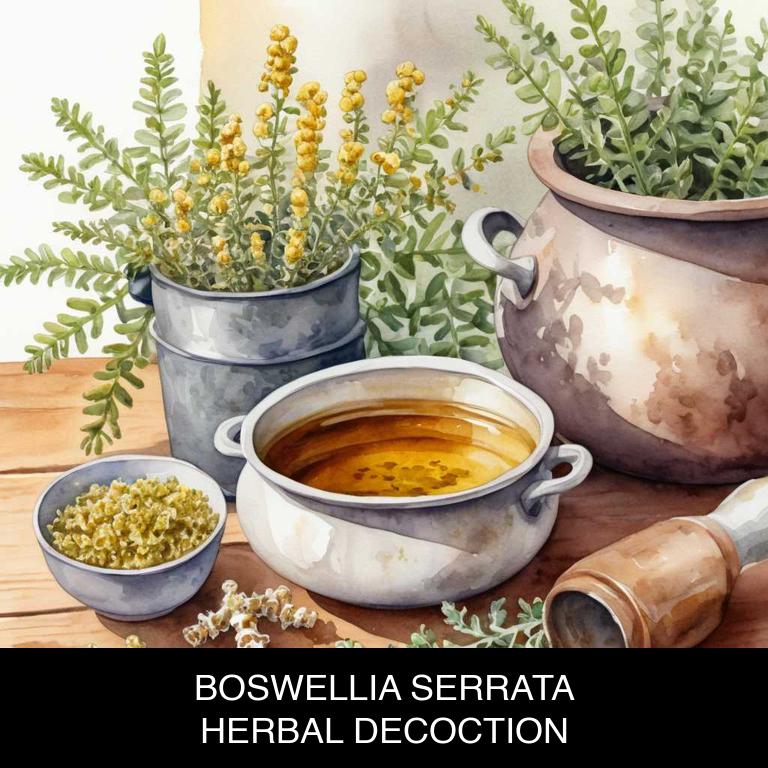
Medicinal Constituents
The list below shows the primary medicinal constituents in Boswellia serrata decoctions that help with inflammation.
- 3-acetyl-11-keto-beta-boswellic acid: A boswellic acid derivative that inhibits the production of pro-inflammatory enzymes and cytokines, thereby reducing inflammation.
- Oleogum resin terpenes: These terpenes have anti-inflammatory properties by inhibiting the activity of pro-inflammatory enzymes, such as COX-2 and LOX, and reducing the production of pro-inflammatory eicosanoids.
- Lignans and phenolic acids: These compounds have antioxidant properties that help reduce oxidative stress and inflammation by scavenging free radicals and inhibiting the production of pro-inflammatory cytokines and enzymes.
Parts Used
The list below shows the primary parts of frankincense used to make decoctions for inflammation.
- Roots: The roots contain Boswellic acids, which are the primary anti-inflammatory compounds responsible for the plant's therapeutic effects.
- Rhyzomes: Similar to roots, rhyzomes also contain Boswellic acids, making them another effective part for decoctions to alleviate inflammation.
- Barks: The bark of Boswellia serrata contains Boswellic acids as well, contributing to its use in decoctions to reduce inflammation.
Quick Recipe
The following recipe gives a procedure to make a basic frankincense for inflammation.
- Harvest 30g of dried boswellia serrata bark and 30g of dried roots from mature trees in the wild.
- Grind the dried boswellia serrata bark and roots into a fine powder using a mortar and pestle.
- Combine 1 teaspoon of the ground boswellia serrata powder with 1 liter of boiling water in a saucepan.
- Steep the mixture for 5-10 minutes and then strain the decoction using a cheesecloth or a fine mesh sieve.
- Store the cooled boswellia serrata decoction in a glass container in the refrigerator for up to 3 days.
8. Withania somnifera
Ashwagandha decoctions helps with inflammation because of its unique composition, rich in antioxidants and adaptogenic compounds.
The herb contains withanolides, which have been shown to exhibit potent anti-inflammatory properties by inhibiting the production of pro-inflammatory cytokines and enzymes. Additionally, ashwagandha's antioxidant activity helps neutralize free radicals that contribute to inflammation, thereby reducing oxidative stress.
By targeting multiple pathways, ashwagandha decoctions can effectively alleviate inflammation, promoting a state of balance and well-being in the body.
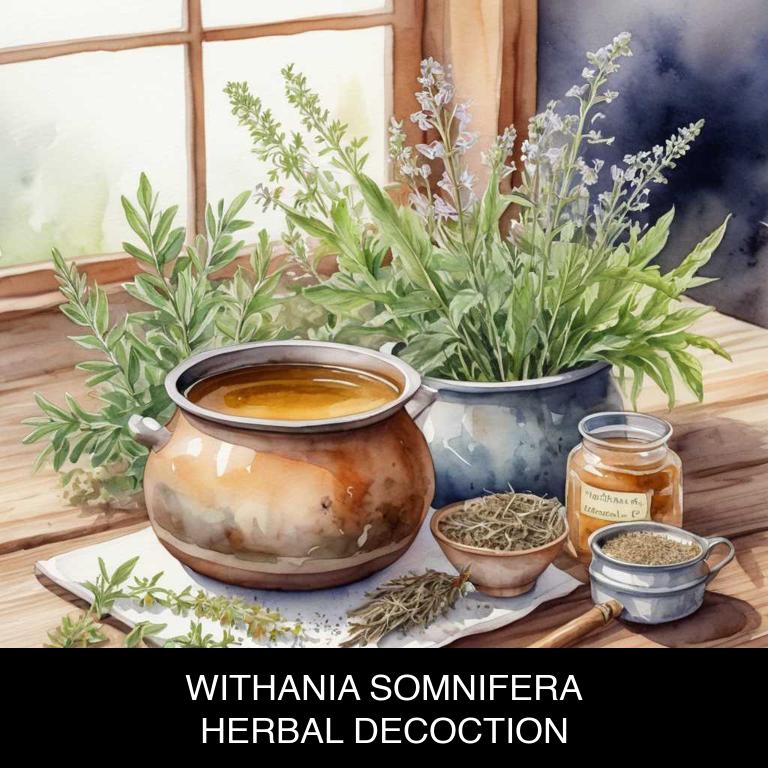
Medicinal Constituents
The list below shows the primary medicinal constituents in Withania somnifera decoctions that help with inflammation.
- Withanolides: These steroidal lactones have potent anti-inflammatory properties, reducing inflammation by inhibiting the production of pro-inflammatory cytokines and enzymes.
- Withaferin a: This withanolide derivative has been shown to inhibit the activity of nuclear factor-kappa B (NF-κB), a key transcription factor involved in the regulation of inflammatory genes, thereby reducing inflammation.
- Withanoside iv: This withanolide glycoside has been found to possess anti-inflammatory activity by inhibiting the production of pro-inflammatory mediators, such as prostaglandins and leukotrienes, which contribute to the development of inflammation.
Parts Used
The list below shows the primary parts of ashwagandha used to make decoctions for inflammation.
- Roots: They are the most commonly used part due to their high concentration of bioactive compounds, including withanolides and flavonoids, which contribute to their anti-inflammatory properties.
- Leaves: Leaves are used for their anti-inflammatory and antioxidant properties, which help in reducing inflammation and promoting wound healing.
- Fruits: The fruits of Withania somnifera contain withanolides and other bioactive compounds that contribute to their anti-inflammatory and antioxidant effects.
Quick Recipe
The following recipe gives a procedure to make a basic ashwagandha for inflammation.
- Weigh 1 teaspoon of dried withania somnifera root in a clean measuring container.
- Boil 8 ounces of water in a saucepan over high heat for 5 minutes.
- Combine the withania somnifera root with the boiling water and reduce heat to medium.
- Simmer the mixture for 10 minutes or until the liquid has reduced by half.
- Strain the decoction through a fine-mesh sieve into a cup and discard the solids.
9. Yucca schidigera
Mojave yucca decoctions helps with inflammation because of its rich antioxidant and anti-inflammatory properties.
The decoction's bioactive compounds, such as saponins and phenolic acids, have been shown to inhibit pro-inflammatory enzymes and cytokines, thereby reducing inflammation in the body. Additionally, Mojave yucca has natural anti-oxidant activity that helps neutralize free radicals, which are known to contribute to chronic inflammation.
This natural remedy offers a gentle and effective way to soothe inflamed joints and tissues, promoting overall health and well-being.
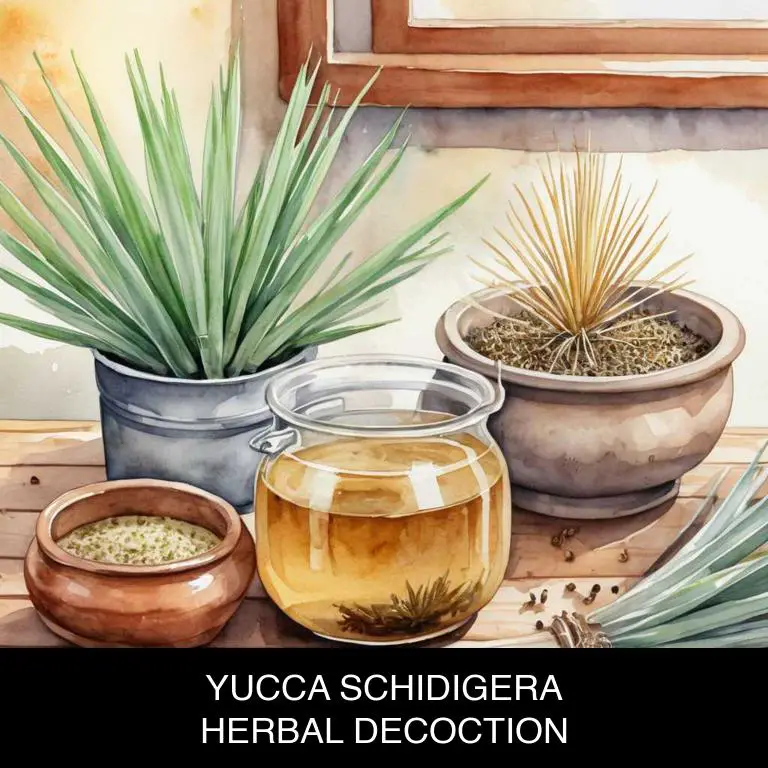
Medicinal Constituents
The list below shows the primary medicinal constituents in Yucca schidigera decoctions that help with inflammation.
- Saponins: These natural glycosides help reduce inflammation by inhibiting the production of pro-inflammatory enzymes, such as COX-2, and by scavenging free radicals that contribute to inflammation.
- Triterpenoids: Triterpenoids, particularly the saponin-rich fraction, exhibit anti-inflammatory properties by suppressing the release of pro-inflammatory cytokines and by inhibiting the activity of inflammatory enzymes, such as lipoxygenase.
- Flavonoids: Flavonoids present in Yucca schidigera decoctions may help alleviate inflammation by exerting antioxidant effects, which help neutralize free radicals and reduce oxidative stress, a key contributor to chronic inflammation.
Parts Used
The list below shows the primary parts of mojave yucca used to make decoctions for inflammation.
- Roots: The roots of Yucca schidigera are used to make decoctions for inflammation due to their high saponin content, which has anti-inflammatory properties.
- Leaves: The leaves of Yucca schidigera are used to make decoctions for inflammation due to their antioxidant and anti-inflammatory properties, which help reduce inflammation.
- Barks: The barks of Yucca schidigera are used to make decoctions for inflammation due to their anti-inflammatory and antiseptic properties, which help soothe and protect the skin.
Quick Recipe
The following recipe gives a procedure to make a basic mojave yucca for inflammation.
- Harvest yucca schidigera roots by carefully digging them up from the ground in late summer or early fall.
- Chop the harvested roots into small pieces weighing approximately 1-2 grams per serving.
- Combine the chopped roots with 1 quart of water in a saucepan and bring to a boil.
- Reduce heat and let the mixture simmer for 30 minutes to extract the active compounds.
- Strain the liquid through a cheesecloth or a fine-mesh sieve into a separate container.
10. Ginkgo biloba
Maidenhair tree decoctions helps with inflammation because it contains potent anti-inflammatory compounds, such as flavonoids and terpenes.
These bioactive molecules work synergistically to reduce swelling and pain by inhibiting pro-inflammatory enzymes and blocking the release of inflammatory mediators. Additionally, the decoction's antioxidant properties help mitigate oxidative stress, which is a key contributor to chronic inflammation.
As a result, maidenhair tree decoctions have been traditionally used to alleviate conditions such as arthritis, gout, and other inflammatory disorders.

Medicinal Constituents
The list below shows the primary medicinal constituents in Ginkgo biloba decoctions that help with inflammation.
- Flavonoids: These plant compounds help reduce inflammation by inhibiting the production of pro-inflammatory enzymes and cytokines, thereby alleviating swelling and pain.
- Bilobalide: A triterpene lactone derived from Ginkgo biloba, bilobalide has anti-inflammatory properties that help suppress the activity of pro-inflammatory cells, such as macrophages and T-lymphocytes.
- Ginkgolides: Ginkgolides, particularly Ginkgolide B, exhibit potent anti-inflammatory effects by inhibiting the platelet-activating factor (PAF), a pro-inflammatory mediator involved in the inflammatory response.
Parts Used
The list below shows the primary parts of maidenhair tree used to make decoctions for inflammation.
- Leaves: The leaves are the most widely used part of Ginkgo biloba due to their high content of flavonoids and terpenoids, which exhibit anti-inflammatory properties.
- Buds: The buds are used because they contain flavonoids and terpenoids, similar to the leaves, which help reduce inflammation and oxidative stress.
- Seeds: The seeds are also used for their anti-inflammatory and antioxidant properties, particularly for their flavonoids and terpenoids content.
Quick Recipe
The following recipe gives a procedure to make a basic maidenhair tree for inflammation.
- Gather 60-120 grams of dried ginkgo biloba leaves and flowers from a trusted supplier.
- Combine the ginkgo biloba with 1 liter of water in a large pot.
- Simmer the mixture over low heat for 30-60 minutes to release active compounds.
- Strain the decoction through a cheesecloth or fine-mesh sieve into a clean container.
- Store the prepared herbal decoction in the refrigerator for up to 3 days.
What is the best combination of herbal decoctions to use for inflammation?
The best combination of herbal decoctions that help with inflammation is a blend of turmeric, ginger, and willow bark.
Turmeric contains curcumin, which reduces inflammation and oxidative stress. Ginger has anti-inflammatory properties that also aid in digestion and relaxation.
Willow bark contains salicin, a natural pain reliever similar to aspirin. Combining these three decoctions can provide a synergistic effect, reducing inflammation and promoting overall well-being.
This blend can be consumed as a tea or added to food for optimal benefits.
What ailments similar to inflammation are treated with herbal decoctions?
Ailments similar to inflammation/decoctions.html">inflammation/decoctions.html">inflammation that are treated with herbal decoctions are various.
For instance, feverish conditions such as flu and tonsillitis can be relieved with decoctions of ginger, lemon balm, and peppermint.
Additionally, herbal decoctions like chamomile, lavender, and passionflower have been used to soothe digestive issues like irritable bowel syndrome (IBS) and diarrhea.